100 000 BC
Humans begin to migrate from Africa to other parts of the world
8500 BC – 6500 BC
In the Sahara Desert region, the people develop the use of pottery and use it for tools and dishes.
6000 BC
Agriculture develops in the Middle East with focus on barley and wheat. The domestication of sheep, goats and cattle precede the agricultural revolution. The animals started to be used for meat, milk and transportation for the people. Later, donkeys also become domesticated, later spreading the practice to southwest Asia.
5000 BC
The continent is hit by a dry phase, drying up the Sahara region and causing the population that settled there to move away.
3500 BC
Two kingdoms of Upper and Lower Egypt emerge into one.
3100 BC
Egypt is consolidated into one political entity under the pharaoh, Narmer, who is the principal administrator of the kingdom. This is regarded as the First Dynasty. Bureaucracies become more centralized under the pharaoh’s administration, run by viziers, tax collectors, generals, artists and technicians. They engaged in tax collecting and the organizing of labour for major public works such as the building of irrigation systems and pyramids.
3100 BC
Ta-Seti (Nubian civilization), one of the first sacral kingdoms in the Nile is invaded by Egypt and destroyed during the First Dynasty. Smaller sacral kingdoms continued to exist but they soon became consolidated into larger kingdoms- two of which included the Kingdom of Sai and the Kingdom of Kerma. The Kingdom of Kerma became one of the Hyskos allies at the time they invaded Egypt at the beginning of the country’s Second Immediate Period.
3000 BC
By this time, the earliest forms of literacy in the world, hieroglyphic writings of ancient Egypt are invented.
3000 BC – 2000 BC
Ancient Somalis domesticate camels. This practice spreads to North Africa and Ancient Egypt
2950 BC
The first stone pyramid in Egypt is built by an architect, Imhotep. It was built at Saqqara, for the Third Dynasty’s King Djoser. It was made by building several layers of stone on top of each other.
2575 BC
The Great Pyramids of Giza are built and are revered as one of the Seven Wonders of the Ancient World.
2181 BC – 2055 BC
The First Intermediate Period of Egypt occurs. The period spanned from the ninth to the eleventh dynasty and was marked by power divisions and civil wars. Two power bases, Heracleopolis (Lower Egypt) and Thebes (Upper Egypt) fought for control of the region. The Thebes came out victorious and reunited Egypt under one ruler, during the eleventh dynasty.
2130 BC
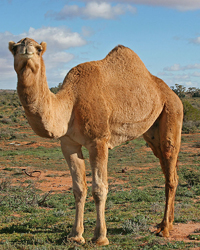 Camel Profile Image Source
Camel Profile Image Source
The Middle Kingdom emerges in Egypt.
2000 BC – 1000 BC
Herding is established in southern Kenya and Tanzania
1580 BC – 1080 BC
The New Kingdom begins in Egypt, bringing an end to the Second Intermediate Period and ushering in one of the nation’s most powerful pre-modern phases. With much political influence on the Mediterranean & Libya, the nation also gains control of Palestine and Nubia.
1000 BC
The expansion of the Bantu people begins. Bantu languages originated in West Africa and began to spread to other parts of Africa; particularly Central, Southeast & Southern Africa. Experts believe that there are approximately 250 to 525 Bantu languages in existence.
1000 BC
The Nok Culture, a highly centralised community of people, is established in central Nigeria. By 500 BC, iron-smelting had become common to the Nok and they produced art in the form of lifelike animal and human figures. The Nok are considered to have disappeared by 200 BC but their influence is evident in the Yoruba Kingdom and Benin.
 Nok sculpture Louvre Image Source
Nok sculpture Louvre Image Source
814 BC
The city of Carthage is established by Phoenicians from Tyre. The region became an influential power and trading entity in the Mediterranean.
760 BC
The Nubian Empire begins. The Kingdom of Kush, possibly arising out of the Kingdom of Kerma (which rebelled for centuries after being absorbed into the Egyptian Empire), invaded Egypt and took over Thebes. The Kushites were later expelled from Nubia by the Assyrian forces. The region later became a centre for cotton-cloth and iron manufacture.
730 BCE
The Nubian Empire begins. The Kingdom of Kush, possibly arising out of the Kingdom of Kerma, which had rebelled for centuries after being absorbed into the Egyptian Empire, invaded Egypt & took over Thebes. The Kushites were later expelled from Nubia by Assyrian forces. The region later became a centre for cotton-cloth and iron manufacture.
525 BC
The Persians invade Egypt under Cambyses II. He defeats the Egyptians in battle at Pelsium in the Nile Delta.
509 BC
The first known treaty between Carthage and Rome is written. It outlines the limitations to their commercial activities and influence over neighbouring regions. The treaty is the earliest record indicating that Sardinia and Sicily were under Carthaginian control.
332 BC
Alexander the Great conquers Egypt. He occupies Egypt and his general, Ptolemy, becomes king and finds a dynasty. During this dynasty, Greek culture was spread throughout Egypt. The Great Lighthouse of Alexandria, in the city of Alexandria, became one of the Seven Wonders of the Ancient World.
300 BC
The Meroitic alphabet replaces Egyptian script in the influential region of Meroe. Made up of 23 characters, the alphabetic script was originally derived from the Egyptian hieroglyphics.
300 BC
Djenne-Djenno, a town in current day Mali, is established. The town is one of the oldest urbanised centres known. It is associated with thriving markets and agriculture, most notably the domestication of African rice. The town is also known as being one of the earliest sites of iron production in sub-Saharan Africa.
264 – 146 BC
A series of three wars (also known as the Punic Wars) between Carthage and the Roman Republic sees Carthage destroyed. Its territory is renamed the Roman Province of Africa. the second of the wars (also known as the Hannibalic War) was one of the most famous of the Carthaginian military leader, Hannibal. Hannibal led his army from Iberia to Italy via the Alps. By the end of the three wars, Carthage was destroyed and the remaining citizens were sold to slavery, as was the customs of the time. This was the beginning of the Roman hegemony in northern Africa.
100 CE – 200 CE
After being deported from Judea for rebelling against Roman rule, Jewish people arrive in Roman North Africa. the significant Jewish presence was evident and many Berber tribes converted to the religion.
3RD Century CE
Christianity begins to take influence in Roman North Africa. The arrival of Christianity demanded the worship of Christ in a church rather than the use of state resources to commemorate kings by their stelae.
Swahili culture begins to take shape because of the interaction between the local Bantu speaking people and the Persian and Arab merchants. The culture eventually began spreading to Tanzania and Kenya and thereafter to Mozambique.
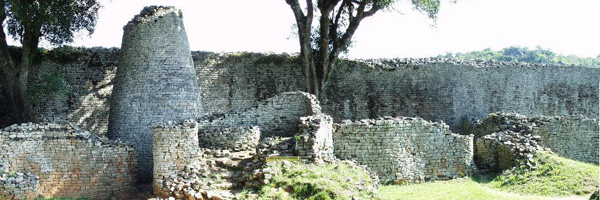 Conical tower by Marius Loots Image Source
Conical tower by Marius Loots Image Source
4TH Century CE
King Ezana of Aksum is converted to Christianity by two Christian traders. This begins the establishment of Ethiopian Christianity. The Ethiopian Orthodox Church provided the institutional support for the monarchy.
The area of Great Zimbabwe is settled. The Ziwa and Gokomere communities survived by farming and mining the land. The area marks the earliest Iron Age settlements known of in the region. Great Zimbabwe would later become the capital of the Kingdom of Zimbabwe and serve as the first city in Southern Africa.
Ghana, the oldest Sudanic empire, is founded. The empire prospered because of the tax revenues from the trans-Saharan trade, linking Sijilmase and Tiaret to Aoudaghost. The empire controlled access to goldfields, even though it was not involved in production. The empire also controlled access to all the salt and gold that went through its territory.
300 CE
The state of Aksum in Eritrea and Ethiopia begins minting its own silver and gold coins as their own Aksumite currency. The region was deeply involved in the trade network between India and the Mediterranean. The region exported ivory, gold and agricultural products.
400 CE – 500 CE
The Khoisan speaking people’s language and customs is absorbed into those of the Bantu speakers. The group is made up of two culturally different people’s, the Khoi and the San. The amaXhosa, the southernmost group of the Bantu speakers, took certain linguistic traits from the Khoisan.
420 CE
Vandals invade North Africa, relieving Rome of her territories in the region. This results in the Berber Kingdom’s regained independence.
6TH Century CE
Aksum’s empire grows, adding the Arabian region of Saba to its territories. With trade routes diverted from the Red Sea to the Persian Gulf, Aksum later declined and severely diminished by 800CE. Aksum also slipped into a decline because of environmental degradation and changes in the global climate.
Settlers from southeast Asia and later, from the east African mainland, settle in Madagascar. Banana and rice cultivation are introduced by the Asian settlers, while cattle and farming techniques are introduced by the Bantu speaking east Africans.
7TH Century CE
Spanish Jews flee persecution under the Visigoths to North Africa, where they made their homes in the Byzantine dominated cities along the Mediterranean coast.
642 CE
Arab Muslims conquer Byzantine Egypt. Under the rule of the Fatimid Caliphate the country increased their cotton production and thrived economically. Minted gold coins called the Fatimid dinar were used for international trade. Tax collection from farms proved lucrative for the Berber overlords – soldiers who had served in the Fatimid conquest – and to the caliphs of the time. During this time slave infantry was used in the military, made up of people from Sudan and Turkey.
711 CE
Arab Muslims have by this time conquered the entire North African region and Islam becomes the dominant religion in the region by the 10th century.
969 CE
Fatimid Rulers seize Egypt and the Egyptian city Al-Qahirah (present day Cairo), is founded.
9TH Century CE
Kanem is founded. Kanuri-speaking nomads founded the Sudanic Empire of Kanem, which achieved power through trans-Saharan trade. Slavery was practiced & slaves were captured from the south & traded for horses from North Africa.
The Kingdom of Nri rises under the leadership of the Eze Nri. Democratically run, men and occasionally women in the Kingdom’s villages took part in decision-making processes.
10TH Century CE
Syrian Shi’ite groups found the Fatimid Dynasty in Maghreb. The groups claimed descent from Muhammad’s daughter Fatima, and had conquered Maghreb by 950 CE and Egypt by 969 CE.
Sotho–Tswana states are formed on the Highveld, south of the Limpopo River. Large towns of thousands of people made up early Tswana states north-west of the Vaal River, with settlers leaving to start their own states over time.
Indian and Arab trade settlement begins in northern Madagascar to take advantage of the Indian Ocean trade. Islam was introduced by the traders.
 Limpopo by TSGT CARY HUMPHRIESImage Source
Limpopo by TSGT CARY HUMPHRIESImage Source
1050 CE
Approximately 250 000 Arab Egyptian nomads settle in Maghreb, spreading the Arab languages and contributing to the decline of the Berber language.
Berber soldiers revolt after tax revenue from farms is diminished. Their violent resistance destabilised the power of the Fatimid caliphs and slowed trade in the region.
Early ironworks are used in what is currently known as Kwa-Zulu Natal.
12TH Century CE
The first state in Southern Africa, the Kingdom of Mapungubwe, arises. The Kingdom attained its wealth from ivory, copper and gold trade with Swahili merchants. Though Mapungubwe was abandoned by the middle of the following century, it formed part of a development that would eventually lead to the creation of the Kingdom of Zimbabwe in the 13th century.
The Akan Kingdom of Bonoman is established in what is now the Brong-Ahafo region of Ghana and eastern Ivory Coast. This kingdom, along with a few others, was predecessors to the powerful Empire of Ashanti which rose in the 18th century.
1115 CE
One of the longest-running dynasties in human history, the Sayfawa (Saifawa) dynasty was founded by Humai (Hummay) ibn Salamna & was centred in Kanem, Chad & then in Borno, Nigeria. This Islamic dynasty ran for 771 years eventually losing the throne in 1886.
1140s CE
Abd al-Mu’min forms the Almohad Empire after declaring jihad on the Almoravids and uniting the northern Berbers against them.
Maghreb sees the establishment of mathematics and literacy, as well as the development of algebra.
1160s CE
European crusaders threaten Fatimid in Egypt, leading to the rise of a Kurdish general, who became well-known for the impressive defence he and his army provided for Muslims.
1171 CE
Saladin becomes ruler of Egypt and the Ayyubid Dynasty begins. Sunni Islam is reinstated in the region and people from Turkey and southern Russia are increasingly brought in as Mamluk slaves to fulfil the military infantry needs. Cairo becomes an important centre of Islamic learning.
13TH Century CE
Christianity in Nubia declines after the church and nobility diminish the monarchy’s authority. Islam slowly became introduced to the region by Sufist Fakirs.
1220 CE
The kingdom of Zimbabwe is established. During the 13th century the Kingdom would construct a series of large stone structures in its capital of Great Zimbabwe. Some of these structures, like “the great enclosure”, were the largest ancient structures in Sub-Saharan Africa. Great Zimbabwe seizes control of the Indian Ocean trade and the wealth it produced from its gold supply.
1230 CE
The Empire of Ghana comes to an end when its capital is seized by Takrur, in northern Senegal.
1235 CE
The empire of Mali is established. The empire of Mali had a huge cultural and historical influence on most of western Africa, including the construction of the Great Mosque of Djenné. The Great Mosque is considered one of the most important centres of learning in medieval Africa. The empire is ushered in by the defeat of Soumaoro Kanté, king of the Sosso or southern Soninke by Sundiata (Lord Lion) of the Keita clan at the Battle of Kirina.
 Mameluke-in-Full-Armour” by Georg Moritz Ebers (1837-1898) Image Source
Mameluke-in-Full-Armour” by Georg Moritz Ebers (1837-1898) Image Source
1250 CE
Mamluk slaves in Egypt have landed aristocracy with significant power. They succeed in establishing their own, Mamluk dynasty after overthrowing the Ayyubid Dynasty. Their military dictatorship controlled Egypt for 250 years.
1260 CE
Egypt, under the Mamluk Dynasty halts the Mongol invasion at the Battle of Ain Jalut. By this time the country’s territories included Palestine and Syria. Egypt had come to be known as a protector of Islam and of Mecca and Medina.
1285 CE
Sakura, a freed slave, usurps the throne to the Mali Empire. Sakura becomes the sixth Mansa of Mali. New conquests such as Gao were made under his rule.
1300 CE – 1400 CE
The Luba people near Lake Kisale in Central Africa are unified under the leadership of Kongolo Mwamba (Nkongolo) of the Balowe clan. Through him, the dynasty of Kongolo, which was later ousted by Kalala Ilunga, was founded. The Luba political system, which spread to other parts of Central Africa, western Congo, southern Uganda, Zambia, Zimbabwe, Mali, Burundi and Rwanda, utilised a system of spiritual kings with direct spiritual access to ancestral spirits. The balopwe, or system of spiritual kings (mulopwe) maintained power through spiritual strength rather than military authority.
Large southeast African states such as Karagwe and Buganda emerge in Tanzania and Uganda. The Buganda Kingdom was founded by the Baganda or Ganda people whose ancestors may have migrated northwest of Lake Victoria 400 years prior.
1324 CE
Mansa Musa, the tenth mansa or emperor of the Kingdom of Mali, makes a pilgrimage to Mecca with a large cavalry which included slaves and animals, all carrying gold which was distributed along the way to Mecca. Eyewitness accounts tell of Musa’s impressive wealth and large procession and his pilgrimage was well-recorded by witnesses along the way. Musa’s generosity inadvertently damaged the economies of the regions he passed through and in large cities like Mecca, Cairo and Medina, gold was devalued for over ten years since his pilgrimage. Musa rectified the damage caused by borrowing excessive amounts of gold from money-lenders at high interest, marking the only occasion during which a single individual controlled the gold prices in the Mediterranean.
1330 CE – 1337 CE
Mansa Musa ruler of the empire of Mali cements the University of Sankore as an institution of learning. At its apex, it housed one of the largest libraries in the world, with between 400,000 and 700,000 manuscripts.
1366 CE
Mamluks invade Nubia during a period of unrest.
1388 CE
After a long period of internal and external struggle and several disputed successions, the Kanem Empire ceases to exist. The final death knell occurs when the remnants of the Empire is conquered by the Bulala people from Lake Fitri, in modern day Chad. The empire was ruled by the Sefuwa dynasty, which continued to rule the Bornu state until 1846 CE, and is counted as the longest ruling dynasty in Africa.
1390 CE
The kingdom of Kongo is established in central Africa by the Bakongo peoples. The capital, M’banza Kongo, was at its height inhabited by about 100,000 people. It was one of the largest cities of Sub-Saharan Africa.
15TH Century CE
The Shilluk Kingdom is established by Nyikang, the Kingdom’s first ruler. The Kingdom’s capital was in Fashoda, South Sudan, along the western bank of the White Nile.
Trading relationships were established between Somalia and Malacca. The main trading commodities were porcelain, cloth, and ambergris. With the trade of wild animals and incense to the Ming Empire in China, Somali merchants were the leading merchants operating between Africa and Asia. This trade served to have such effects as influences over the Chinese language by introducing Somali terms to the region’s languages.
Ethiopia seeks diplomatic contact with European kingdoms in almost 500 years.
Merina is established in the central highlands of Madagascar. The region controlled the island by the 19th century.
1400 CE
The Sayfawa Dynasty moves its capital to Bornu, an empire established by the Kanuri people and led by the Sayfawa. The Sayfawa Dynasty is the first known south-Saharan monarchs to import firearms.
1430 CE
A prince from the Kingdom of Zimbabwe, Nyatsimba Mutota, travels north to expand commerce and to find new sources of salt. 350 km north of Great Zimbabwe, he finds a city from which the Kingdom of Mutapa – also known as Wilayatu ‘l Mu’anamutapah or mwanamutapa (Lord of the Plundered Lands) – is established.
 Tower, Great Zimbabwe Image Source
Tower, Great Zimbabwe Image Source
1450s CE
Great Zimbabwe is abandoned, possibly because of a decline in trade, political instability, exhausted mines, and climatic change which resulted in water shortages and famine.
The Lunda peoples are united under the union between their queen Rween and a Luba member of royalty from the Ilunga Tshibinda. The Lunda kingdom was later expanded by their son, Mulopwe Luseeng. His son, Naweej further expanded the empire and became the first known emperor of Lunda. His title was mwato yamvo (mwaant yaav, mwant yav), the Lord of Vipers.
1468 CE
Songhai leader, Sonni Ali, captures Timbuktu from the Tuareg. His heirs were deposed after his death in 1492 by General Muhammed Ture (he later founded the Askiya Dynasty). Under Ture’s rule, Timbuktu became a centre for Islamic learning.
1480 CE
Mutope, son of Nyatsimba Mutota who founded the Kingdom of Mutapa, dies and the empire is split into two smaller empires: Torwa and Mutapa.
1483 CE
Portuguese explorers land in what was then known as the Kingdom of Kongo. Following this, the ruling king at the time, Nzinga a Nkuwu, converted to Christianity. This was the beginning of the Portuguese slave trade in the region. It would also be the beginnings of a turbulent and often shifting relationship between the two states, which culminated in the Kingdom of Kongo becoming a vassal state of Portugal about 380 years later.
16TH Century CE
The Wadai Kingdom is founded by the Tunjur people, east of Bornu. The kingdom gained independence and became an aggressor against its neighbours, Bornu and Durfur, in the 18th century.
The Saadis, a nomadic Arab nomad tribe that claimed descent from Muhammad’s daughter, conquered and united Morocco. They removed Portugal from the western coast of Morocco and prevented the Ottoman Empire from reaching the Atlantic.
The Nubian kingdoms of Nobadia and Makuria are Islamized. The last Christian region, Soba, is conquered under Abdallah Jamma. Alodia, of which Soba was the capital, later fell under the Funj Sultanate. Funj herders who migrated to Alodia and expanded the kingdom from 1504 – 1505 converted to Islam by the end of the 16th Century.
Through the establishment of markets along the Zambezi River, the Portuguese gain a measure of military and political control over Mutapa, the empire which arose out of the fall of Great Zimbabwe under Nyatsimba Mutota.
The Portuguese fail to establish commercial control on the Swahili Coast after facing Swahili resistance.
The Sakalava Kingdom is established on the west coast of Madagascar.
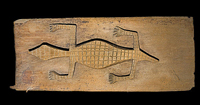 “Aristide Maria MHNT ETH AC 1176 Porte sculptée” by Didier Descouens Image Source
“Aristide Maria MHNT ETH AC 1176 Porte sculptée” by Didier Descouens Image Source
The Oyo Empire (in today’s Nigeria) rises after being conquered in 1450 by Nupe. The Empire lasted 200 years until becoming a protectorate of Great Britain in 1888.
1500 CE
By this point the Kingdom of Mutapa has conquered several surrounding kingdoms, including the Kingdom of the Manyika, as well as the coastal kingdoms of Kiteve and Madanda. At its largest expansion, the Kingdom of Mutapa cowered most of modern day Swaziland, Zimbabwe, Mozambique and the northern part of South Africa.
1508 CE
Under emperor Lebna Dengel, Ethiopia forms relations with Portugal. This connection aided Ethiopia during Ahmad ibn Ibrahim al-Ghazi’s attacks to the empire, through the provision of weapons and soldiers. The Adal general and imam, Ahmad ibn Ibrahim al-Ghazi (also known as the “the Left-handed”), was defeated and helped to re-establish Ethiopian rule under the emperor’s son, Gelawdewos. This was noted as one of the first proxy wars in the region, with Portugal and the Ottoman Empire took sides in the conflict.
1517 CE
Egypt becomes part of the Ottoman Empire after an easy defeat following the failure of the Mamluk military defence to keep up with modern weaponry technology, which included handguns and canons.
1585 CE
The Luba Kingdom was established in central Africa by King Kongolo Maniema of the Upemba people. The Kingdom had one million people paying tribute to the King at its peak. The capital of the Kingdom would be a centre of trade extending both to the Atlantic and Indian oceans. The Luba culture was held in high esteem by surrounding smaller kingdoms and in return for tribute, these rulers would be allowed to take Luba ancestors as their own.
1591 CE
Under the leadership of Ahmad al-Mansur, the newly powerful Moroccan state invaded Songhai and held control of the region until the 17th century. They had control over the gold trade.
17TH Century CE
The Wadai Empire emerges in in Chad and the Central African Republic. A revolt against the Islamic dynasty established by the Maba people occurred during this time.
The Tsitambala Kingdom is established on the east coast of Madagascar.
The Dahomey Kingdom is established in what is presently-known as Benin, with Agbome as its capital.
 Central East Africa 1750 Image Source
Central East Africa 1750 Image Source
1603 CE
Morocco is split into two sultanates, Fes and Marrakesh, following the death of Ahmad al-Mansur.
1623 CE
Maravi leader, Mzura, turns on their Portuguese allies to assist the Shona after defeating his rival, Lundi. A few years later, he welcomed the return of the Portuguese for trading purposes. The Maravi Empire ceased to exist after Mzura’s death.
1628 CE
Following a battle, the Portuguese could replace leadership in Mutapa with a lord under their control, who would sign treaties in Portugal’s favour, giving them unlimited control over mineral export rights. By undermining trade, the Portuguese successfully destroyed the mwanamutapa system of government and the region was in serious decline by 1667.
1652 CE
The Dutch establish a permanent settlement at Table Bay in the Western Cape of what is currently known as South Africa after initially establishing a replenishing station for passing ships. Enslaved people from West Africa were brought in to work farms in the region.
 “VOC” by Joseph Mulder Image Source
“VOC” by Joseph Mulder Image Source
1659 CE
The first Khoi-Dutch War occurs with no apparent victors. The Dutch, however, claimed the Cape region under a ‘right of conquest’ which they assumed after the war. A series of wars between Khoikhoi peoples was instigated by the Dutch settlers in successful efforts to gain control of their land. In addition, European diseases (such as small pox) which the Khoikhoi had no immunity to, contributed to thousands of Khoikhoi deaths.
1672 CE
Moulay al-Rashid, founds Alaouite Dynasty and is succeeded by his brother, Ismail ibn Sharif (1672–1727). They reunited Fes and Marrakesh under the Morocco and imported slaves from the Sudan to build their military and to strengthen the unity of the country.
1673 CE
The Second Khoikhoi-Dutch War occurs, lasting four years.
1684 CE
The Rozwi (Rozvi) empire is established on the Zimbabwean Plateau by Changamire Dombo. The empire fought of Portuguese invasion which formed part of Portuguese attempts to gain control of their gold trade. Driving them off the Zimbabwean Plateau, the ensured that Europeans had little presence in the Eastern Highlands of the region.
18TH Century CE
Bornu becomes a centre for Islamic learning.
The Cape colony under the Dutch grows, bringing slave people from Indonesia, Mozambique and Madagascar. The Khoikhoi resisted the northward movement of the settlement by utilising raids, and guerrilla warfare, thus slowing the colony’s expansion for that period.
An all-female bodyguard armed with muskets is established to protect King Agaja in Dahomey, which later developed into a powerful army and assisted in the defeat of the Kingdom of Savi in 1727. Calling themselves ahosi or mino, they were referred also referred to as ‘Amazons’ by European commenters.
1701 CE
The Ashante conquer Denkyira, which offers them access to European coastal trade.
1729 CE
Portuguese presence and authority is removed from the Swahili coast with the help of Omani Arabs, with the area eventually becoming part of the Sultanate of Oman. Trade was never quite recovered to earlier levels of success.
1798 CE
Egypt is invaded by Napoleon, with French occupation finally removed in 1801 with the aid of British and Ottoman forces. This marked the start of the rivalry between the British and the French for control over Egypt.
19th Century CE
Under Queen Ranavalona I, approximately 150 000 Christians are killed in Madagascar after Christianity is banned.
1804 CE
The Fulani War begins, starting as a jihad by Gobir (in present-day Nigeria) leader, Usman dan Fodio. Dan Fodio founded the Sokoto Caliphate which lasted until 1903 when northern Nigeria was conquered by the British.
1821 CE
The Funj of north Sudan are conquered by the Pasha of Egypt, Muhammed Ali.
1815
The Mfecane (also known as Difaqane or Lifaquane) period begins during which much warfare occurs between the peoplesof southern Africa. Starting with the rule of King Shaka, the period centred on King Mzilikazi’s reign from 1826 – 1836 and finally ended in approximately 1840. States such as modern-day Lesotho were formed during this time.
1818
The Battle of Mhlatuze River occurs, during which King Shaka of the Zulus defeats the Ndwandwe.
Fleeing to Mozambique at around 1820 along with Ngwane chief Sobhuza, they established the Gaza Kingdom and caused the resident Tsonga people to the Northern Transvaal over the Lebombo Mountains.
1820s CE
Shaka, of the Zulu people, establishes a centralised Zulu kingdom. It would go on to conquer most of its neighbouring kingdoms, and in turn cause mass disruption within much of Southern Africa. Shaka is famous for various military inventions such as the short stabbing spear and a centralised military force not known to the region before.
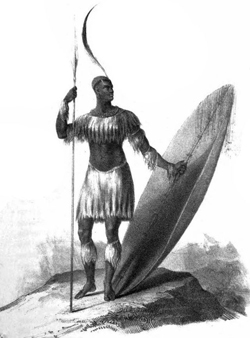 KingShaka by James King Image Source
KingShaka by James King Image Source
1826 CE
King Mzilikazi of the Matabele starts his reign in the Transvaal region of Southern Africa. During his ten-year reign, he attempted to decimate all opposition and reorganised the region in efforts to establish the Ndebele order, resulting in a depopulation of the area. His reign forms part of the Mfecane or Difaqane period during which much warfare occurred between the peoples of southern Africa.
1830s CE
The Rozwi Empire on the Zimbabwean Plateau is conquered by invading Nguni from Natal and falls into ruins.
1837 CE
The arrival of Boer settlers drive the Matabele people north of the Limpopo causing them to settle in Zimbabwe in an area which is now known as Matabeleland.
1850s CE
German and British missionaries penetrate most of Southern Africa paving the way for further colonial expansion.
1870s CE
The Kingdom of Buganda (Uganda) becomes a thriving nation-state with impressive naval fleets and significant wealth. Supplanting their rivals, Bunyoro, as the most important state in the region, the kingdom later became a province of the British Uganda Protectorate in the early 20th century.
1880 CE
The first Anglo-Boer War occurs between British colonisers and the Boer settlers from the Transvaal Republic.
1881 CE
The Madhist war in Sudan was one of the most serious anti-colonial rebellions of its time. After heavy casualties, the war ended in Britain’s favour, and led to the establishment of the colonial entity the Anglo-Egyptian Sudan Administration.
1883 CE
The first Franco-Hova War occurs, during which Madagascar is invaded by the French. The war resulted in the ceding Antsiranana in the north to France and a large payment to the heirs of Joseph-Francois Lambert, with whom the Lamberts charter was controversially signed by Prince Radama II in 1855. The war ended with the signing of the Treaty of Tamatave in 1886, which gave control over Malagasy foreign policy to the French.
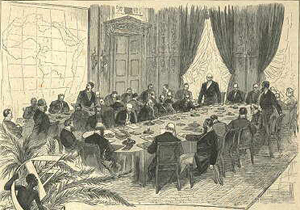 “Afrikakonferenz” by Gartenlaube 1884 Image Source
“Afrikakonferenz” by Gartenlaube 1884 Image Source
1884 CE
Improvement of medicines and inventions, such as the machine gun and the steam boat, opens for the European conquest of the interior of the African continent. In 1884, the Berlin Conference is held to divide Africa between the various colonial empires. This begins the scramble for Africa, a decade of rapid conquest by various European powers of the African continent. Ethiopia is the only part of Africa which remains independent.
1895 CE
Italy invades Ethiopia, attempting to create a colonial state. After about a year of conflict, Ethiopia emerges victorious.
The second Franco-Hova War occurs, with the intention of the French to bring the island completely under its protectorate. Starting with the seizing of Tamatave, the French Army marched to Antananarivo (the capital) under General Duchesne. A treaty was eventually signed making Madagascar a full Protectorate of the French Government.
1899 CE
The Second Anglo-Boer War occurs and becomes known as the most destructive modern armed conflict in South Africa’s history.
1914 – 1918 CE
What is known as the Great War, breaks out in Europe. European powers conscript large amounts of soldiers from their colonies in Africa. The returning soldiers are trained in combat and are confident in their abilities to gain independence. The end of the Great War in Europe marks the beginnings of many liberation movements on the African continent.
 Royal Irish Rifles ration party, Somme, July 1916 Image Source
Royal Irish Rifles ration party, Somme, July 1916 Image Source
1935 CE
Ethiopia is conquered in the second Italian-Ethiopian war. Ethiopia is however liberated by British forces in 1941 as part of the Second World War.
1939 – 1945 CE
The second world war in Europe brings with it an increased demand for independence from African states. European colonial powers are weak from the war, and American fear of Soviet influence in Africa creates a global political climate in favour of decolonisation.
1948 CE
The National Party in South Africa rises to power, paving the way for the Apartheid regime and its legislations to be implemented in South Africa.
1951 CE
Libya becomes the first of the colonised states in Africa to gain its independence.
1952 CE
Egypt gains its independence through a revolution by the Free Officers Movement. This would be the first native Egyptian regime since the Fatimids were defeated in 1171 CE.
1954
The Algerian War for Independence from France begins on 1 November.
1956 CE
Sudan and Tunisia gained their independence.
1960 CE
This year is known as the “year of Africa”. Much of the former French colonial Empire was falling apart, and several British colonies also gained their independence this year. This would spell independence for a large amount of African states. Mali, Senegal, Madagascar, Democratic Republic of Congo, Ivory Coast, Niger, Chad, Central African Republic, Nigeria, Burkina Faso, Benin, Gabon, Mauritania and Togo all gained independence in this year.
1961 CE
Tanganyika, later what was to become Tanzania, and Sierra Leone gained independence from the British Empire.
1962 CE
After a brutal war, Algeria gained its independence from France. Rwanda, Burundi and Uganda also became independent from Belgium and the Britain in this year.
1963 CE
After more than a decade of various anti-colonial campaigns, such as the Mau-Mau Uprising, Kenya gained its independence from Britain. Uganda also gained its independence from Britain.
1963 CE
The Organisation of African Unity is created. The aims of the organisation were to fight against colonialism, keep territorial integrity and better the lives of Africans in general. It was also an organisation aimed at creating broader unity within the African continent.
1964 – 1968 CE
Malawi, Botswana, Mauritius, Lesotho, Swaziland, Gambia, Zanzibar and Zambia gain their independence from Britian.
1975 CE
Portugal was one of the first European colonial nations to begin its conquest of African lands, and was one of the last to leave. Several lengthy colonial wars in Mozambique and Angola led to dissatisfaction in Portugal and a military coup. As a result São Tomé and PrÁncipe, Cape Verde, Angola, and Mozambique, all became independent.
1990 CE
After a lengthy fight against the apartheid government in South Africa, Namibia is the last of the African states colonised by European powers to gain independence. This occurs on 21 March, 1990.
 Tintenpalast-Windhoek Image Source
Tintenpalast-Windhoek Image Source
1994 CE
South Africa has its first democratic elections, ending white minority rule, and becoming the last nation in Africa to throw off its colonial shackles. The first black president of the republic, Nelson Rolihlahla Mandela, is elected.
1998 – 2003 CE
The Great War of Africa would be one of the largest interstate conflicts after the second world war in Europe. It involved eight African nations and a variety of different militias. The conflict began as an internal conflict in the Democratic Republic of Congo, but came to involve a host of various countries and militias. It is estimated that between 3 and 6 million people perished in that war.
2001 CE
The Organisation of African Unity is disbanded in favour of the African Union, as the OAU was seem as largely ineffectual and as a “dictators club”. The AU launched in 2002 in South Africa. the objects of AU are to continue to advance the development of the continent and to achieve unity and solidarity amongst African states.
2009 CE
Boko Haram members begin assassinations and major kidnappings. In 2013, they begin a series of attacks on schools as they kidnap hundreds of school girls, with the intent of raping and selling them.
2011 CE
South Sudan becomes an independent state after a lengthy and bloody civil war.
2014 CE
West Africa begins to experience the largest outbreak of Ebola in history, with multiple countries being affected by the epidemic.
